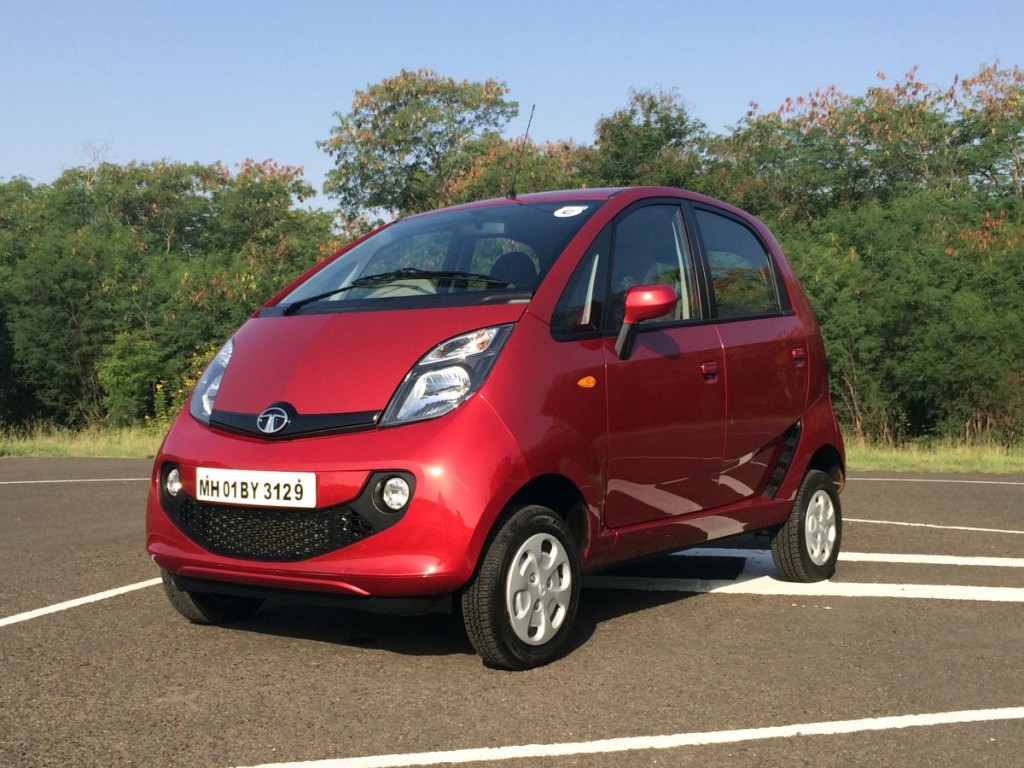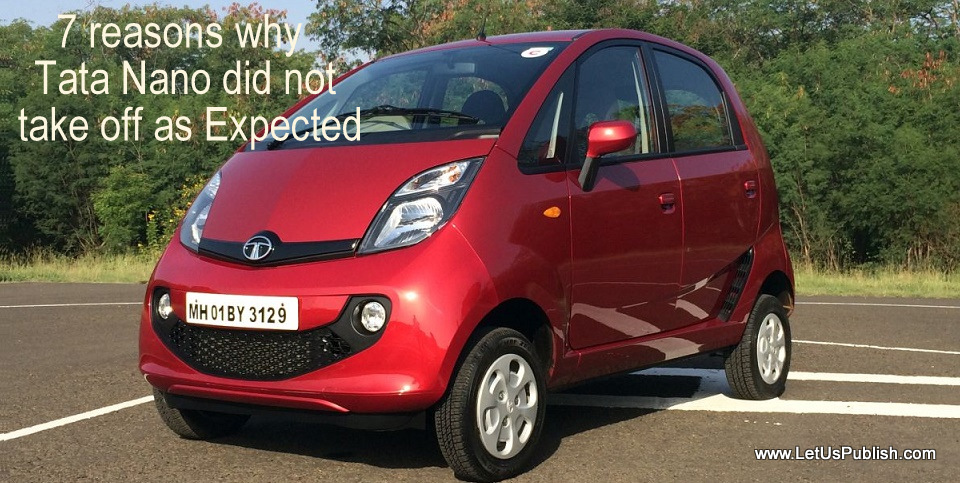Imagine owning a new car at a price just a little higher than the latest iPhone! Tata Motors weaved a colorful dream for all Indians when they announced the production of the Nano. The concept had taken India by storm, right from the start. Even with the omen of the Singur fiasco hanging over its head, the Tata Nano rambled ahead with a strength that was admirable.
Unfortunately, however, the low-cost car that was aimed at the middle-classes across India did not take off very well. Here are a few reasons that could be attributed to the reason Tata Nano did not take off as expected and failed to make a mark in the Indian automotive industry.
- Chipping away due to the ‘cheap’ image: The moniker ‘world’s cheapest car’ which had initially brought an interesting ring to it – as the promise of a car that was easily and economically accessible – is no longer being used as a lucky charm. In fact, Tata Motors seems to have finally grasped that such a positioning has made the Nano appear to be fragile and unreliable to the general public. In fact, Ratan Tata admitted the same in an interview to CNBC, where he said, “It (Nano) became termed as a cheapest car by the public and, I am sorry to say, by ourselves, not by me, but the company when it was marketing it. I think that is unfortunate.”
- Looking at the ‘looks’ factor: The average Indian is more concerned about looks. In a country where even a fat, paunchy, bald man advertises for a tall, thin, fair bride – would a Tata Nano not appear as a blown up ‘match-box’ or what many people called a ‘covered auto rickshaw’? The design of the Tata Nano did not go down too well with the target Indian consumer, who concentrate more on how something ‘looks’. Low pricing notwithstanding, the average Indian wanted a car that his neighbour would envy. That didn’t quite happen with the Nano.

- Negative publicity & failed PR management: Another major issue faced by Tata Nano was the negative publicity which seemed to overshadow it. Yes, a few Tata Nano’s caught fire – but, weren’t there a hundred other Tata Nanos that did not? The PR cell at Tata could not do enough to contain the collateral damage done by the spiraling negative publicity, which was one of the reasons Tata Nano did not take off.
- Increasing competition of second hand car market: The small car industry in India has seen a sudden boost. According to an Indian Brand Equity Foundation report, the small car segment in India is expected to grow to 2.66 million by 2020. Datsun with its Redi-Go, Hyundai Eon, Renault A-Entry are some of the smaller cars that are all set to take the Indian market by storm, which definitely is another blow to Tata Nano. In India, it is a known fact that buyers always want to get a better deal at the same price or even at a lower price than the Tata Nano. This has been a major factor that people prefer to buy a second-hand car over a new Tata Nano. Moreover, financing options for a second-hand car are far easier to process than for the Tata Nano. In fact, in the tier 2 and 3 cities, where the Tata Nano was primarily targeted, it was seen to be a major difficulty for the middle-classes to get adequate loans and financing options when they wanted to purchase a Tata Nano.
- Engineering marvel gone wrong? According to an IBEF report Tata Motors were pioneers in revolutionising the supply chain by making partners of Bosch and Delphi in the Tata Nano innovation. However, though the Tata Nano was lauded to be an engineering marvel at one level, on the other it seemed to have gone wrong. There was much that the Nano lacked, such as poor air bags, space for child-seats, etc. Max Mosley, chairman of the Global New Car Assessment Programme points out, “Poor structural integrity and the absence of airbags are putting the lives of Indian consumers at risk.”
- Expectation versus reality: The Indian audiences had expected a wonder car which would be affordable to their pockets and give their image a boost. However, the requirements of the Indian middle-class was not met by Tata Nano: an average family of four had difficulty fitting in the car; there was no boot-space (the quintessential carry-everything-with-you Indian family’s biggest disappointment); the car was not meant for the rough Indian roads – which all went down very negatively into the Indian psyche, and hence the lack of acceptance of Tata Nano. The Tata Nano target segment was the tier 2 and 3 cities where the condition of the roads is not at all desirable, and the safety factor of the car was heavily compromised. People with large families also were unhappy with the leg and boot space, and the extreme lightweight of the car. Abhimanyu Chatterjee, an IT employee working with an MNC from Kolkata, who bought a Tata Nano when it was first launched said, “I got into the craze and bought a Tata Nano, but now it is lying in the family garage. I am not at all confident of taking the kids out in the car, because the car is so lightweight I think it is dangerous for families to travel in it!”
- Problem of product placement: Every individual aspires to be something more than he is currently is. The same is true for the average Indian. Tata Nano, by positioning its car for the largely rural areas and placing it as ‘everyman’s car’ made a big mistake – as people did not necessarily want something ‘cheap’ but something that is more ‘aspirational.’ It is here that the Tata Nano went terribly wrong, and managed to alienate itself from the people it was actually aiming towards.
Today, the Tata Nano has been trying to revamp itself and bring about a modernized avatar, with more safety features and a better marketing strategy in place. Of course, the price of the car has also seen an increase, thanks to these changes in tactics and techniques.
It is now to be seen if the new and improved version of the Tata Nano takes off as expected, unlike the earlier version which was, in reality, quite a major disaster.
Read More articles-



I have bought a Nano LX on 13-03-2016 and used more than 45,000 km till now. Cluster unit and headlight switch unit were replaced on warranty. Clutch disc replaced in 2013 at my cost just after 20,000 km. 4 Tyres replaced at 25,000km.
The vehicle delivered me on the payment of Rs 10,000/- and granted 100% finance at about 4600/- EMI of 60 months of which I had made all payments till date regularly. Insurance premium is also very low, I paid Rs 3100/- for last full cover.
I am getting average 16.5 km/ltr driving with my family with A/c and 19.5 km without A/c. Very comfortable for parking in city and easy to drive. The a/c is powerful and cooling for first 100 km. The excess noise from engine is horrible sometimes. I had to replace the muffler
Petrol tank is too tiny hence need to feed every 200km that’s very disturbing. While driving in hills area once I lost break due to the excess use of clutch. This happened within 50km, I had to wait till the vehicle cool down.
The worst experience is that car was break-down due to starter plug complaint just 5 days after purchase. The road assistance team came and took the car to service centre and told me that Relay unit found faulty. It was found faulty 2 times, both times my family was not with me. Thank God!!!
Over-all, the car is good for the price and worthy for my family. If checking the bills I had spent minimum amount for maintance…
Also, the change is inevitable….Nano faces tough competition from budget cars, second sales, limited features of comfort and convenience, the triangle shape of car is undesirable, and diminishing quantity of production is a warning for new buyers.
In short, I love my first car… Thank you Tata for fulfilling my dream for a car…it’s true that your offer for 100% finance made that dream real.
Thank you for sharing your experience Sir/Mam.
Great points. I truly believe that they lacked in market research. How could someone miss what Indians are like? Especially Tata? They are an Indian company and must know about buying habits about Indians. They’ve been in the industry for so long and still!
Also, as you mentioned, there are so many things missing in the car. From a safety perspective, many other cars are missing. But Tata has so many others things which are missing. Moreover, the features they put in… they barely tried to highlight those. Only thing they used for marketing was ‘affordability’. People want good things that are affordable, not just affordable things! There’s a huge difference there.
hey yogita….
what can you expect in just one lakh. this is the best onc can have if anyone is desire to have a car. also you are damn true about their marketing strategy, they portrayed the car as cheap car and we indian loves to show off.
Rohan You better check the price of the nex gen nano automatic i am sure you will get a shocker
Btw which car you roll on
Hey Yogita, I think that the increase in competition from second-hand car market is the real culprit here. Tata Nano is an impressive car for the price, which one should understand by the fact that there is no other player in the market with such a product. It’s the best of Ratan Tata and it wasn’t for everyone.